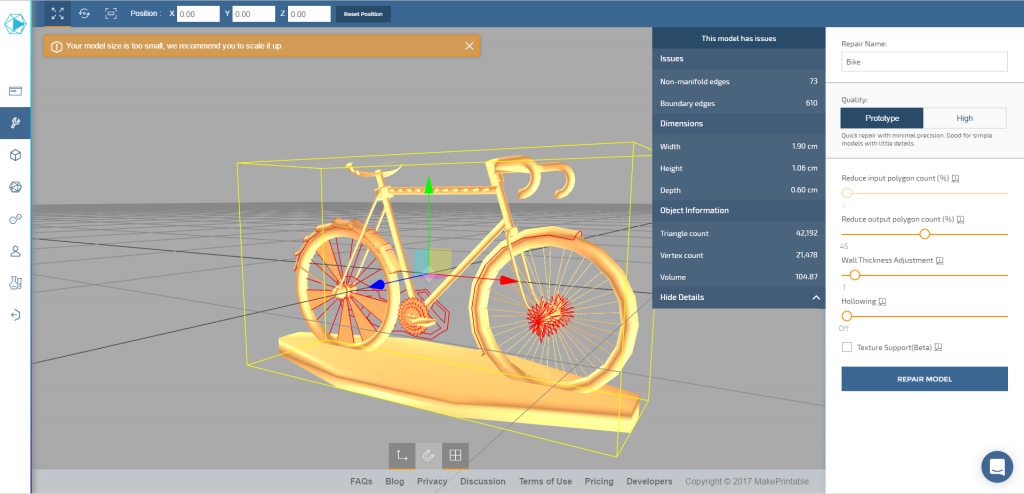
Cloud-based 3D model repair service MakePrintable launched version 1.0 today.
The company has been in beta for quite a while, having multiple testers around the world examine their service’s capabilities.
I’m impressed with how this company has undertaken their careful launch: a considerable period of testing where they genuinely gathered and reacted to user feedback. I happened to be one of the testers and witnessed the system progress from its initial version to what we see today in version 1.0.
The system is now a slick 3D model repair service that’s entirely cloud-based. And that means it’s integrated with other cloud services in multiple ways: you can, for example, automatically import files from a variety of places you might find 3D models, including cloud storage and Thingiverse. I expect them to add more integrations in the future.
MakePrintable is capable of handling a great many input file types. Currently they list the following file formats: .DAE, .FBX, .3DS, .ASE, .OBJ, .IFC, .XGL, .ZGL, .PLY, .DXF, .LWO, .LWS, .LXO, .STL, .X, .AC, .MS3D, .COB, .SC, .XML, .BVH, .CSM, .PK3, and .3MF. I don’t even know what some of those are! But nevertheless, this wide capability opens up the possibility of more extensive use of non-solid 3D models being transformed into 3D printable versions.
The appearance of MakePrintable is good news for the 3D printing community, as changes in Netfabb have caused some to look elsewhere for 3D repair functionality. Netfabb is perhaps the most popular “fix it” tool and has been for some time. However, it was acquired by Autodesk in 2015 and underwent some possibly confusing rebranding. This confusion, and the possibility of losing Netfabb in some users’ minds, led many to discover alternative 3D model repair services such as MakePrintable.
While much of MakePrintable’s beta test period revolved around squashing bugs, increasing capabilities and smoothing out the user interface, they also established their monetization regime.
Currently the company offers three levels of service:
“FREE”, which permits up to three comprehensive repairs per month. There is no charge for this service and it does not expire.
“PRO”, which offers up to 10 repairs per month and added functionality: instant repairs, color texture support, hollowing support and adjustable wall thickness. This level is priced at USD$7.00 per month, or as low as USD$0.70 per “fix”.
“PLUS”, which offers up to 50 repairs per month and all the other features. This is priced at USD$25 per month, or about USD$0.50 per fix.
The pricing scheme is going to be interesting to watch going forward: will users choose to use the pay-for services, when they could use some other free services that might not be as easy or as powerful?
On one hand, USD$0.50 per fix is almost literally free. Can you afford USD$0.50? That’s equivalent to less than a minute of a USD$50/hr 3D designer’s time. For professionals, I think using this service is obvious.
On the other hand, DIY folks who are accustomed to using free open source tools might balk at paying anything for such a service, even those that are very low priced.
For those folks MakePrintable seems to be providing the FREE service; if you’re fixing more than three 3D models per month, they’re thinking you should pay for the service. I think that’s quite reasonable.
Via MakePrintable

